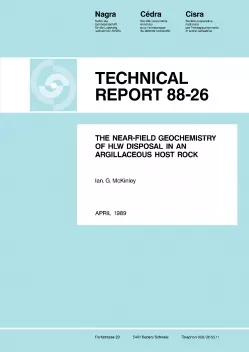
Technical Report NTB 88-26
The near-field geochemistry of HLW disposal in an argillaceous host rock
Current concepts in Switzerland envisage the disposal of vitrified highlevel waste (HLW), encapsulated in massive steel canisters, horizontally into tunnels which are backfilled with compacted bentonite. In the Project Gewähr 1985 study, the geochemical aspects of the performance of these barriers in a repository situated at a depth of ~ 1300 m in a crystalline host rock were evaluated. This report extends that analysis to consider an alternative repository concept at a depth of ~ 850 m in an argillaceous host rock.
In general, the longevity of the engineered barriers is little affected by the choice of host rock – the analysis predicts that bentonite will retain its favourable physical and chemical properties for more than 106 years, the canister will last more than 103 years and the complete degradation of the glass matrix will take over 105 years. These components also ensure that most of the near-field is chemically buffered in reducing, mildly alkaline conditions. After failure of the mechanical integrity of the canister, the release of many important nuclides is further constrained by their low solubilites. Transport of dissolved radionuclides occurs in the bentonite only by diffusion, which is limited by various retardation mechanisms (sorption, anion exclusion, etc.). One of the key roles of the bentonite in this regard is to act as a filter, preventing migration of particulate or colloidal species.
Various factors are, however, specific to the argillaceous host rock case. Rock mechanical constraints necessitate the use of a liner during the operational phase and this liner may be impractical to remove. Because oxidation of the host rock is of potential concern, it is desirable that this liner is as tight as possible but, after waste emplacement, there are advantages to it being homogeneously permeable. The geochemistry of the engineered barrier/rock interface is generally more complex in the sediment case relative to crystalline – due not only to potential oxidation but also to the possible increased significance of natural organics, colloids and microbial activity.
In conclusion, the expected radionuclide release rates from the near-field are very low, even with fairly conservative assumptions on the performance of various barriers. There are indications that a more realistic analysis would demonstrate negligible releases of almost all key nuclides. The justification of such a treatment depends, however, on building up a more fundamental understanding of some of the processes involved and validation of the models/databases used by a variety of methods, possibly including natural analogue studies.
